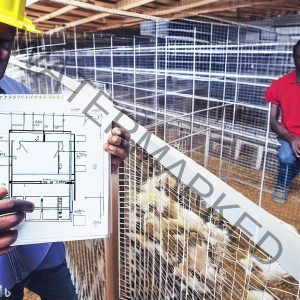As an architect with expertise in designing animal farms and pens, creating an efficient and suitable poultry house is a crucial aspect of poultry farming. Constructing a well-designed pen for chickens requires careful planning and attention to detail.
Before diving into the construction process, it’s essential to understand the different types of poultry housing and their benefits. There are three primary types of poultry housing: free-range, semi-intensive, and intensive.
Free-range housing allows birds to roam freely outdoors, while semi-intensive systems offer some outdoor space with access to shelter. Intensive housing, on the other hand, involves confining birds to indoor spaces. Each system has its advantages and disadvantages, so consider the needs of your birds and your specific farming goals.
So, in this step-by-step guide, we will cover everything you need to know to build an effective poultry house for different types of birds, including chickens, ducks, and turkeys. We will also provide dimensional guides to ensure optimal space utilization and bird welfare.
Beginners Guide: Poultry House Construction Guidelines
Designing a poultry house is a critical aspect of successful poultry farming. Whether you’re raising chickens, ducks, or turkeys, creating a suitable and efficient housing environment is essential for the well-being and productivity of your birds.
Read Also: [Beginners Guide] How To Build A Poultry House For Layers
So while we prepared to get our hands dirty on various aspects of poultry house construction, including different types of poultry houses, roofing options, modern farm layouts, and shed designs available in PDF format, sit back and read on.

Step 1: Selecting the Site
Choosing the right location for your chicken house is crucial. Ensure it is on elevated ground to prevent flooding, and it should receive ample sunlight throughout the day. Proper ventilation is essential, so avoid areas with excessive wind exposure. Adequate drainage is also necessary to keep the pen dry and prevent waterlogging.
Read Also: Poultry House Plan Design Pdf [A-Z Building Plan]
Step 2: Design and Layout
Plan the layout of your chicken house to maximize space and efficiency. Include separate sections for feeding, watering, egg collection, and roosting. Each chicken requires at least 2-3 square feet of space inside the house, and the roosting area should be elevated from the ground.
Step 3: Construction Materials
Choose durable and weather-resistant materials for your chicken house. Common options include wood, metal, and concrete. The walls should provide insulation and protection from the elements. Additionally, install proper flooring to make cleaning easier and prevent moisture buildup.
Read Also: [Pdf Sample] Poultry Farming Business Plan In Kenya Docx
Step 4: Ventilation and Lighting
Proper ventilation is essential to maintain good air quality and prevent respiratory issues among the chickens. Install windows and vents strategically to ensure fresh air circulation. Additionally, incorporate artificial lighting to maintain a consistent day-night cycle for the birds, which can positively impact their productivity.

Step 5: Nest Boxes and Perches
Nest boxes are crucial for hens to lay eggs comfortably and safely. Place them in a secluded area to provide privacy. Perches are also essential, as chickens prefer to roost at night. Install them at a height of about 2-4 feet above the ground.
Read Also: [Pdf Sample] Livestock Farming Business Plan Docx
Step 6: Biosecurity Measures
Implement biosecurity measures to prevent disease outbreaks. Install footbaths at the entrance to the chicken house to disinfect footwear. Quarantine new birds before introducing them to the flock to avoid potential infections.
Here Is The Download Link To Poultry House Construction Guidelines
Duck House Construction Guide
Ducks have different housing requirements compared to chickens. Follow these guidelines for constructing a suitable duck house:
Step 1: Pond Access
Ducks require access to water for swimming and foraging. If possible, construct the duck house near a pond or provide a small artificial pond within the pen.
Step 2: Protection from Predators
Ducks are vulnerable to predators, so ensure the duck house has secure walls and a roof. Install wire mesh to prevent entry by snakes, rats, and other predators.
Step 3: Nesting Boxes
Ducks prefer nesting on the ground, so provide nesting boxes with straw or hay for comfortable egg-laying.
Step 4: Water Drainage
Ducks can be messy, so design the flooring to facilitate easy cleaning and proper drainage.
Here Is A Vidoe Guide On Instructional Guide To Build A Simple Poultry Pen
Turkey House Construction Guide
Turkeys require more space than chickens or ducks. Here’s how to construct an appropriate turkey house:
Step 1: Size and Space
Allow a minimum of 5-10 square feet per turkey to accommodate their large size. The house should have sufficient height to prevent crowding.
Step 2: Roosting and Nesting
Install sturdy roosts and nesting boxes to support turkeys’ weight and provide suitable areas for egg-laying.
Step 3: Outdoor Area
Turkeys enjoy the outdoors, so provide a fenced outdoor space for them to roam and forage.

Step 4: Heating and Ventilation
Turkeys are sensitive to temperature fluctuations. Install proper heating systems and ventilation to maintain a comfortable environment.
Types of Poultry Houses
Free-Range Housing: This system allows birds to roam outdoors while providing access to sheltered areas. It promotes natural behaviors and healthier birds.
Semi-Intensive Housing:
Birds have some outdoor space but are confined to sheltered areas during certain periods. It strikes a balance between free-range and intensive systems.
Intensive Housing:
Birds are confined indoors with controlled environments. This system maximizes production efficiency but requires careful management.
Types of Roofs Used in Poultry Houses
Gable Roof:
A classic triangular-shaped roof that provides excellent rainwater drainage. It’s commonly used in poultry houses.
Hip Roof:
All sides slope downwards, offering increased stability and wind resistance.
Gambrel Roof:
Resembles a barn roof and provides more vertical space. It’s suitable for larger poultry houses.
Flat Roof:
Simple and cost-effective, but requires proper drainage systems to avoid water accumulation.
Modern Poultry Farm Layout
Modern poultry farms aim for optimal space utilization and streamlined operations. The layout typically includes:
Production Area: The central area where poultry houses are located.
Feeding and Watering Stations: Strategically placed to ensure easy access for birds.
Egg Collection Area: Designed with nest boxes for convenient egg retrieval.
Manure Management Area: Proper waste disposal is crucial for maintaining hygiene.
Biosecurity Measures: Controlled entry points to prevent disease transmission.
Poultry Farm Shed Design (PDF)
Poultry farm shed designs in PDF format offer detailed plans and dimensions for construction. These designs consider factors like bird welfare, ventilation, and ease of maintenance. Accessing PDFs can provide valuable insights into creating a functional and efficient poultry house.
Chicken Layer Cage Dimensions (PDF)
For layer farming, the use of cages can optimize space and egg production. Chicken layer cage dimensions provided in PDFs ensure proper space allocation for each bird, considering factors like perching, nesting, and feeding.
Best Structure for a Chicken House
The best structure depends on various factors, including the climate, bird type, and farm size. Generally, a well-ventilated and insulated house with proper lighting and access to food and water is ideal.
Average Size of a Poultry House
The average size varies depending on the bird type and farming method. For example, a standard chicken house can range from 400 to 600 square feet, accommodating around 100 to 200 chickens.
Best Floor for a Poultry House
Concrete floors are common as they are durable, easy to clean, and provide good insulation. However, using raised floors with wire mesh allows droppings to fall through, keeping the birds clean.
Best Floor for a Hen House
For hen houses, a slatted floor system or raised wire mesh floor is recommended. It allows droppings to fall through, minimizing contact with eggs.
Best Bedding for a Chicken Coop
Popular bedding options include straw, wood shavings, and sawdust. These materials provide insulation, moisture absorption, and comfort for the chickens.
Best Bedding for Poultry
Wood shavings and straw are commonly used for poultry bedding. These materials are affordable, readily available, and suitable for various bird species.
Raised or Ground-Level Chicken Coops
Raised chicken coops offer better protection from predators, improved ventilation, and easier egg collection. Ground-level coops are simpler and can work well in certain environments.
Simple Poultry House Design
Simple designs are cost-effective and easy to construct. They often consist of open-sided shelters with basic roofing, suitable for free-range or semi-intensive systems.
Small Poultry House Design
Small poultry house designs are ideal for backyard or hobby farms with limited space. These designs are efficient and cater to the needs of a smaller flock.
Local Poultry House Design
Local designs consider regional climate, materials, and bird preferences. They can be highly effective and culturally suitable for specific areas.
Do I need separate houses for different bird species?
While separate houses are ideal, you can design multi-functional pens with designated sections for each bird.
Can I use recycled materials for construction?
Yes, as long as the materials are clean, sturdy, and safe for the birds.
How often should I clean the poultry house?
Regularly clean the house and replace bedding to maintain hygiene and prevent diseases.
Is natural lighting enough for poultry houses?
While natural lighting is beneficial, supplementing with artificial lighting can enhance bird productivity.
What biosecurity measures are essential?
Implement quarantine protocols, footbaths, and restricted visitor access to prevent disease spread.
Are gable roofs suitable for all types of poultry houses?
Yes, gable roofs are versatile and work well for most poultry house types.
Can I use the same design for ducks and chickens?
While some aspects may overlap, it’s best to tailor the design to the specific needs of each bird species.
How important is biosecurity on a poultry farm?
Biosecurity is crucial to prevent disease outbreaks and ensure the health of the flock.
What is the primary consideration for poultry house flooring?
Flooring should be easy to clean, provide good insulation, and promote bird comfort.
Conclusion
Designing a poultry house involves careful planning and consideration of various factors to ensure the well-being and productivity of the birds. From selecting the right roof type to choosing suitable bedding and flooring, every aspect plays a crucial role in creating a successful poultry farm. Utilize available PDF resources and tailor the design to meet the specific needs of your birds and farming goals.




